Thick, soft, and delicious. Sicilian pizza is the perfect treat for a lazy Friday night in front of the TV, or for a large party. It can’t go wrong with Sicilian-style pizza! With this easy, Sicilian pizza dough recipe, you’ll be making better pan pizza than ever!
This article will show you the base Sicilian pizza dough recipe, as well as explain what makes Sicilian different, and how you can adjust the dough for the perfect crust.
What Makes Sicilian Pizza Different?
Sicilian pizza, or sfincione, is a thick-crust pizza that originates from the island of Sicilian in Italy. Most commonly made into a rectangular shape. What makes it different from other types of pizza is the thick, but light and airy crust. The exterior of the crust should be crispy, while the interior should be soft. Sicilian pizza is closer to topped focaccia than a flatbread (like Neapolitan pizza).
Is Sicilian Pizza Dough Different Than Regular Pizza Dough?
There is nothing unique about Sicilian pizza dough. The trick to a good crust is high-quality ingredients and long, slow fermentation. Due to the thicker crust, Sicilian-style pizza should be baked longer at a lower temperature than e.g. Neapolitan or New York-style pizza. This requires a few small adjustments.
Sicilian Pizza Dough Hydration
To make the crust soft and airy, you want a higher hydration dough, meaning it contains more water compared to flour. The reason is that due to the thickness of the crust, you need to bake it for around 30 minutes. This gives time for more water to evaporate. Increased hydration also softens the gluten strands in the dough, something that will make the crust softer and give it larger air pockets. A good starting point is therefore 65-70% hydration. But feel free to play around both with higher and lower hydration to get the crust you desire.
Click here if you’re interested in dough hydration, and how you can use it to adjust your pizza dough to perfection.
Ingredients for Sicilian Pizza Dough
Like any pizza dough, a Sicilian pizza dough only really needs 4 basic ingredients: flour, water, yeast, and salt. But to make the perfect dough, we’ll make a few small adjustments, and add a couple of more ingredients.
Compared to most other styles of pizza, Sicilian pizza has a thick crust. This requires a longer baking time at a lower temperature. The heat of a brick oven would crisp and brown a Neapolitan pizza in only 60-90 seconds, but a Sicilian-style pizza needs far longer time and is often baked at around 400°F (205°C) for 30 minutes. It’s hard to get the proper crispiness and browning of the crust at this temperature. You, therefore, want to add oil and sugar to the dough, in addition to the 4 base ingredients.
Let’s take a look at each ingredient:
Flour
Flour is the most important ingredient in any pizza dough. It’s where a lot of the flavors come from, and it also determines gluten development.
You can use high-quality bread flour, or even better ab Italian pizza flour. A great all-around pizza flour Caputo Pizzeria.
The ideal flour also depends on how long you want to ferment the dough. Generally, longer fermentation times mean more flavor. You can even cold ferment the dough in the fridge.
Water
Always use clean water for pizza baking! You want the water to be at room temperature. Too cold water will slow down the yeast, and too hot, will make the yeast work too fast.
Yeast
I use active dry yeast due to convenience, and I always have Caputo Lievito Active Dry Yeast at hand. But feel free to use any yeast you have lying around!
Different types of yeast will however affect the flavor of the dough slightly. You also have to adjust the amount of yeast depending on the type you use. 10g of fresh yeast is roughly equivalent to 5g of dry yeast, and 3g of dry active yeast.
Salt
Salt slows down the yeast slightly, but most importantly salt is a flavor enhancer. Fine sea salt or kosher salt are the best options.
Extra Virgin Olive Oil
Oil conducts heat and will help the pizza crust bake faster and get crispier. That’s a huge advantage when you bake pizza at a lower temperature for a longer period of time. Oil is part of the secret to a crispy Sicilian pizza crust!
You don’t need a fancy, expensive bottle of oil, as it will add little or no flavor to the final product. I recommend just using a basic extra virgin olive oil, that you can find in any grocery store.
Sugar
You also want a little bit of sugar in the dough. This will help the crust brown faster at a lower baking temperature, as well as add a slight sweetness to the crust.
Sicilian Pizza Toppings
You can top the pizza with anything you’d like. But a good tomato sauce and fresh mozzarella cheese is a great start!
If you want to go traditional, anchovies, onion, and tomatoes are common toppings. It might also be served with or without the cheese. But you can of course try your personal pizza favorites. Personally, I love spicy salami and olives. If I have guests over, I often add different toppings to each half of the pizza for some variation as well. The options are endless!
How to Bake Sicilian Pizza at Home for the Perfect Crust
We have all experienced soggy or raw pizza dough. It’s not very pleasant! Luckily there is a better way to bake pizza.
The main reason pan pizza turns out soggy is the lack of temperature. You want to bake the pizza on a hot surface, that conducts heat well. This will give you a perfectly crispy pizza crust!
A Pizza Stone or Steel for a Crispy Crust!
That’s where a pizza stone or steel comes to the rescue!
Personally, I prefer pizza steels, because they conduct heat better, are more durable, and are easier to clean and maintain than a pizza stone. For cooking Sicilian pizza, I recommend the Conductive Cooking Square 3/8 inch Pizza Steel.
The Conductive Cooking Square Deluxe is an extra large
The reason I recommend the Conductive Cooking Square Deluxe is that it’s incredibly durable and solid
You won’t have to worry about soggy Sicilian-style pizzas with the Conductive Cooking Square!
Pre-Cook the Dough
Due to the long baking time, cheese and toppings might be baked for too long if you leave them in the oven for 30 minutes. I, therefore, recommend pre-cook the crust only with tomato sauce, before adding your toppings for the last 10 minutes of the cooking process.
If you have a broiler or grill element, you can get an even better result by adding the toppings at the very and turning on the broiler. But if you use this trick, keep an eye on the pizza! It goes from done to burnt very fast.
Okay, let’s put it all together and make some delicious Sicilian pizza!
Instructions – How to make Sicilian Pizza Dough
This recipe makes a rectangular Sicilian-style pizza at around 12×16 inches or 30x40cm. But feel free to adjust the dough if you want a larger or smaller pizza.
- 500g flour
- 335g warm water (67%)
- 5g dry active yeast
- 15g olive oil
- 7.5g salt
- 10g sugar
1. Mix the Ingredients and Make the Dough
Start by adding room-temperature water to a mixing bowl. Dissolve the sugar and yeast, and add the flour gradually while mixing. Add salt, and mix the dough so it comes together as a shaggy dough.
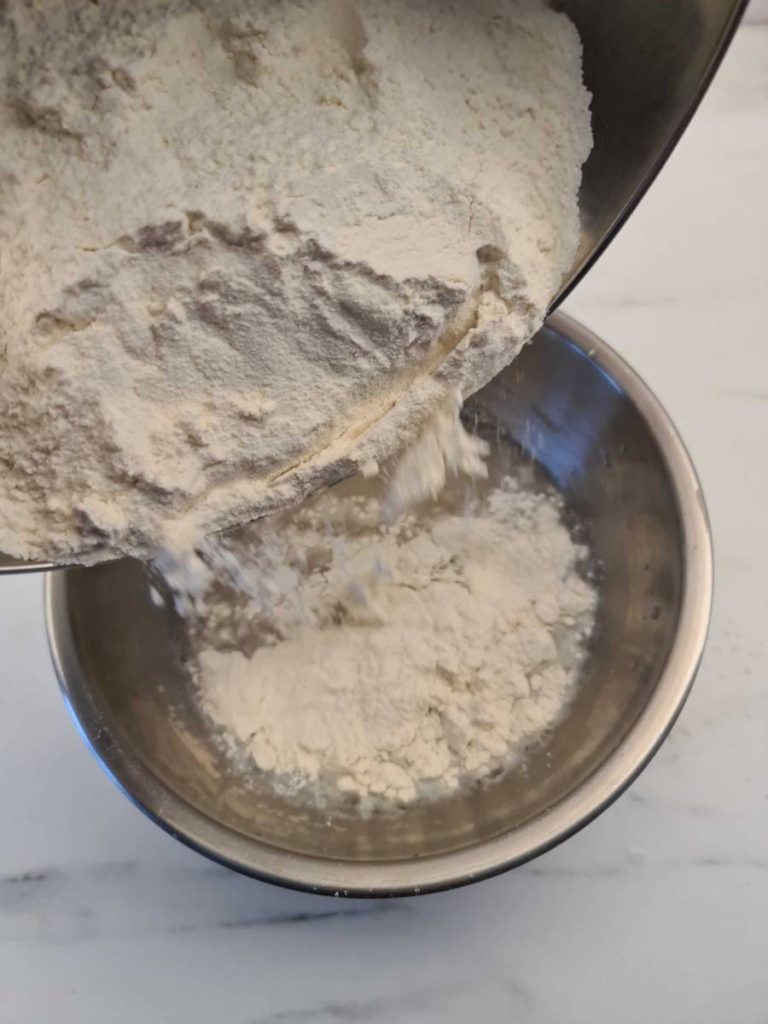
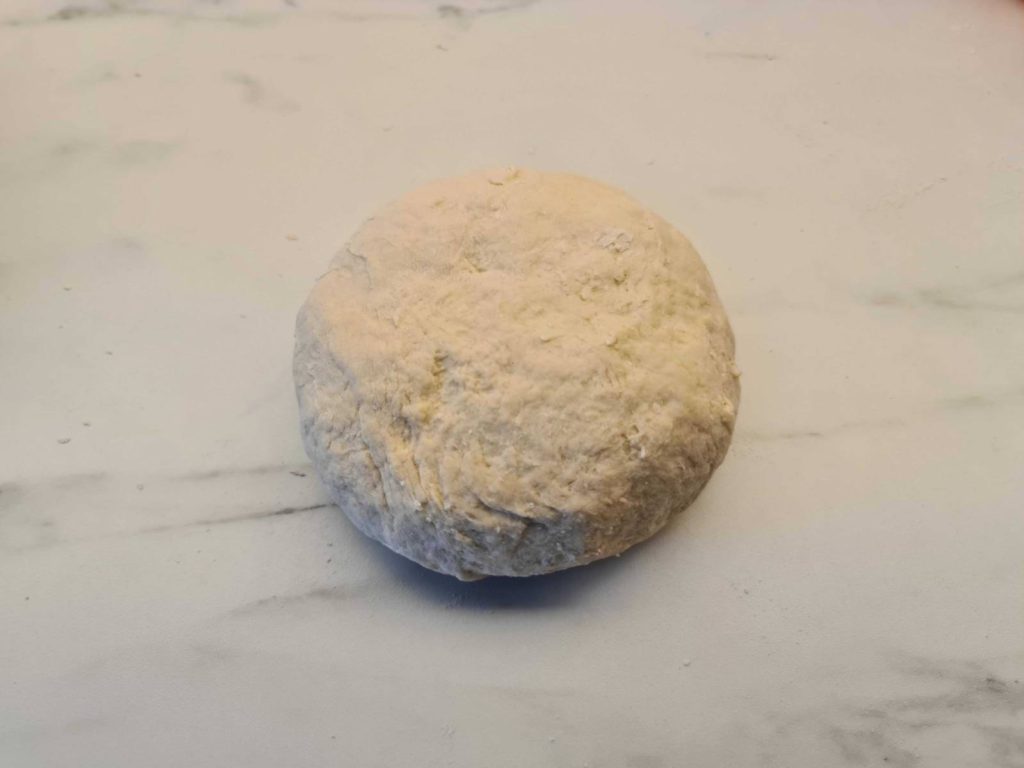
2. Let the Gluten Develop Using Autolyse
Place the dough in an air-tight container, and cover the bowl with plastic wrap. Alternatively, you can place the dough on your countertop and the bowl upside-down on top, to cover the dough.
Let the dough rest for around 30 minutes. This will let the water hydrate the gluten in the dough, and start forming gluten strands. This process is called autolyse and is an alternative to forcing water into the gluten through kneading.
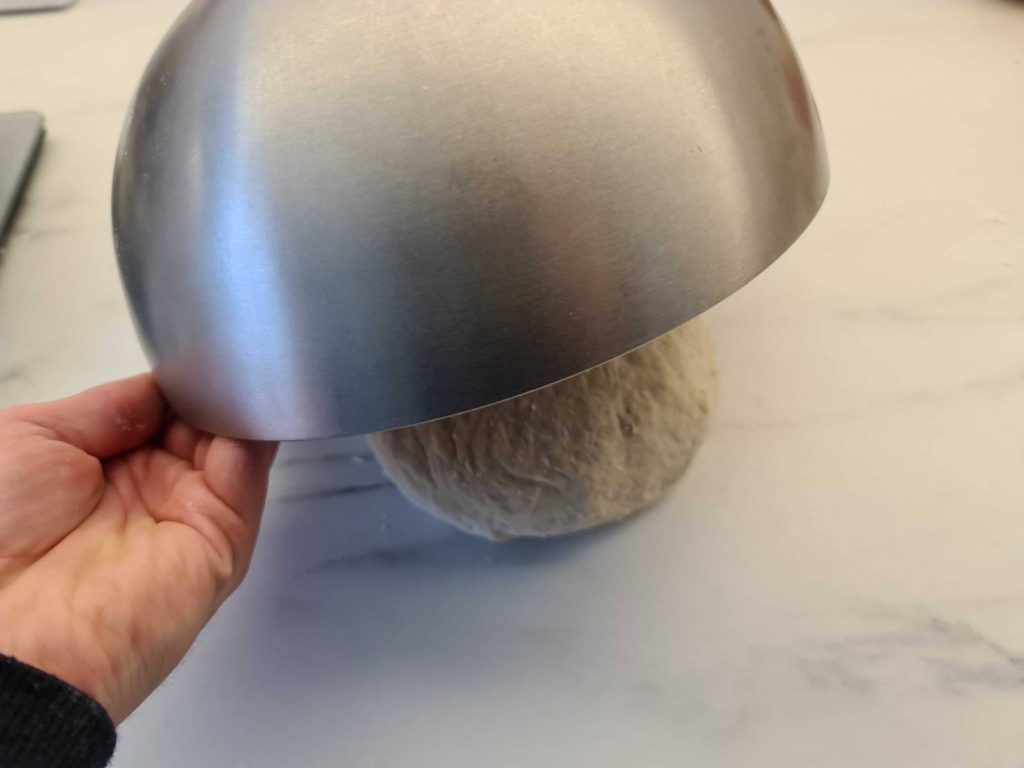
3 . Knead the Dough
After 30 minutes, take the dough out of its container and knead it into a smooth, springy dough ball. This step can either be done by hand or in a stand mixer This should only take a couple of minutes since we did the autolyse step.
To make sure gluten has developed sufficiently, you can use the windowpane test.
4. Let the Dough Rise
Place the dough in a lightly oiled airtight container or a bowl covered with plastic wrap, and let the dough rise for 4-6 hours.
You can also cold ferment the dough in the fridge overnight for additional flavor. Simply place the bowl or airtight container in the fridge, and take the dough out at least 2 hours before you’re going to top and bake the pizza.
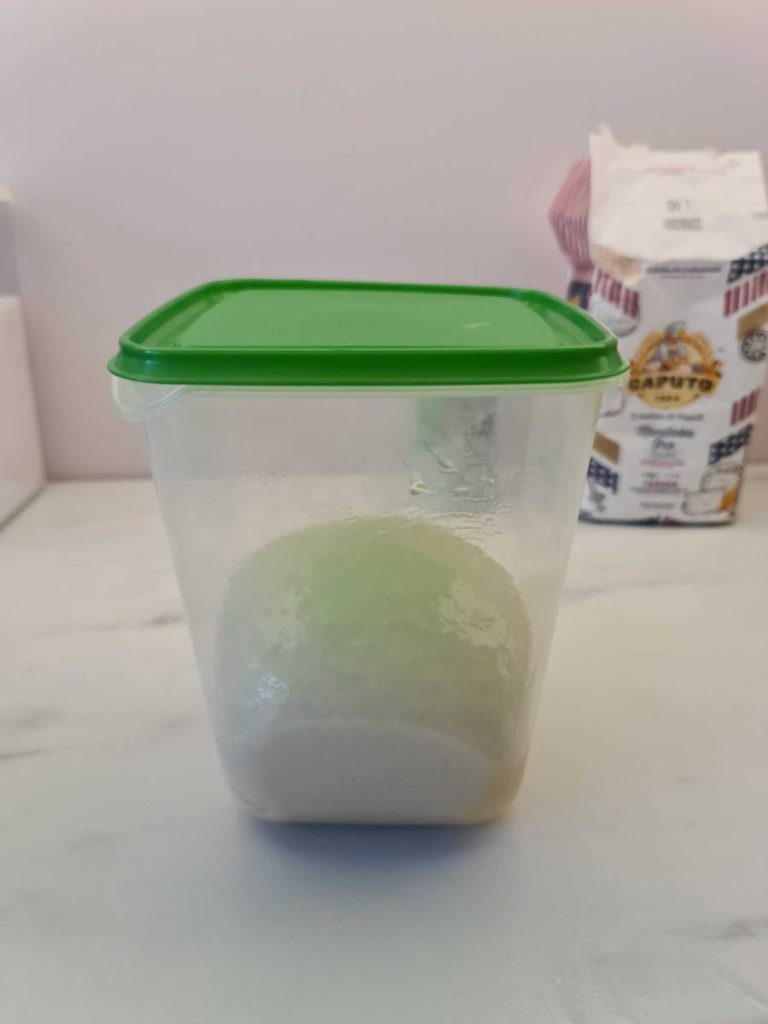
5. Stretch and Shape the Sicilian Pizza Dough
Remove the dough from the rising container. And stretch it out directly on a baking sheet or a sheet of parchment paper. Use your fingertips and press it outwards from the middle into a rectangular shape. But make sure to keep an edge around the pizza. This will create a nice, raised crust!
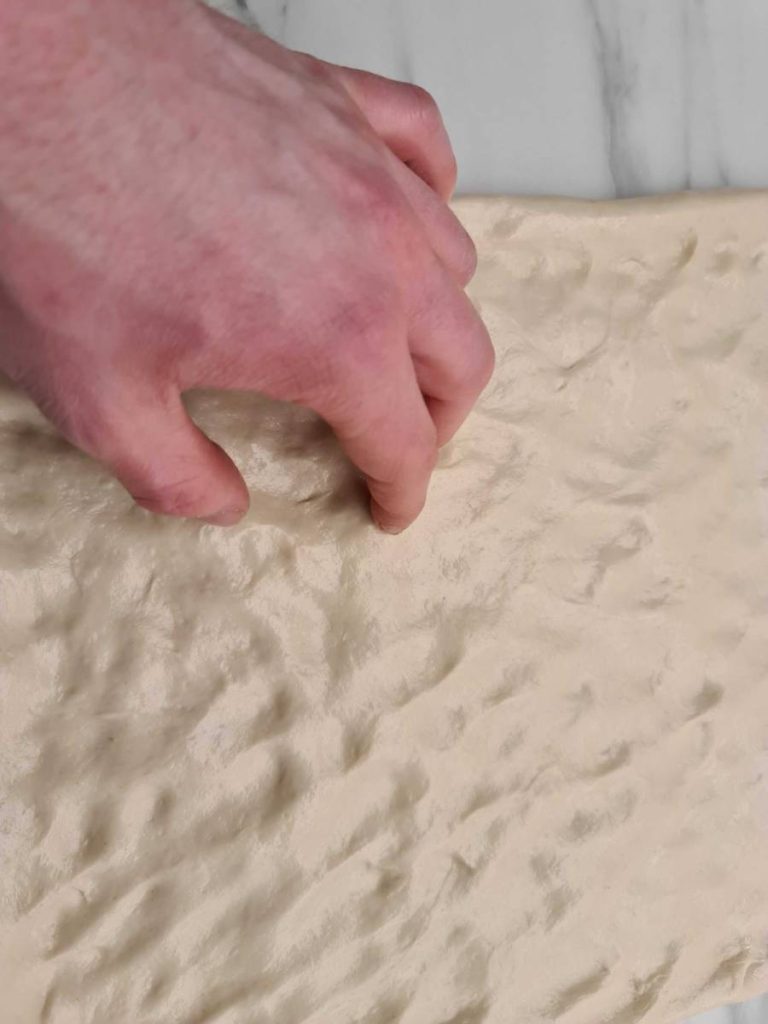
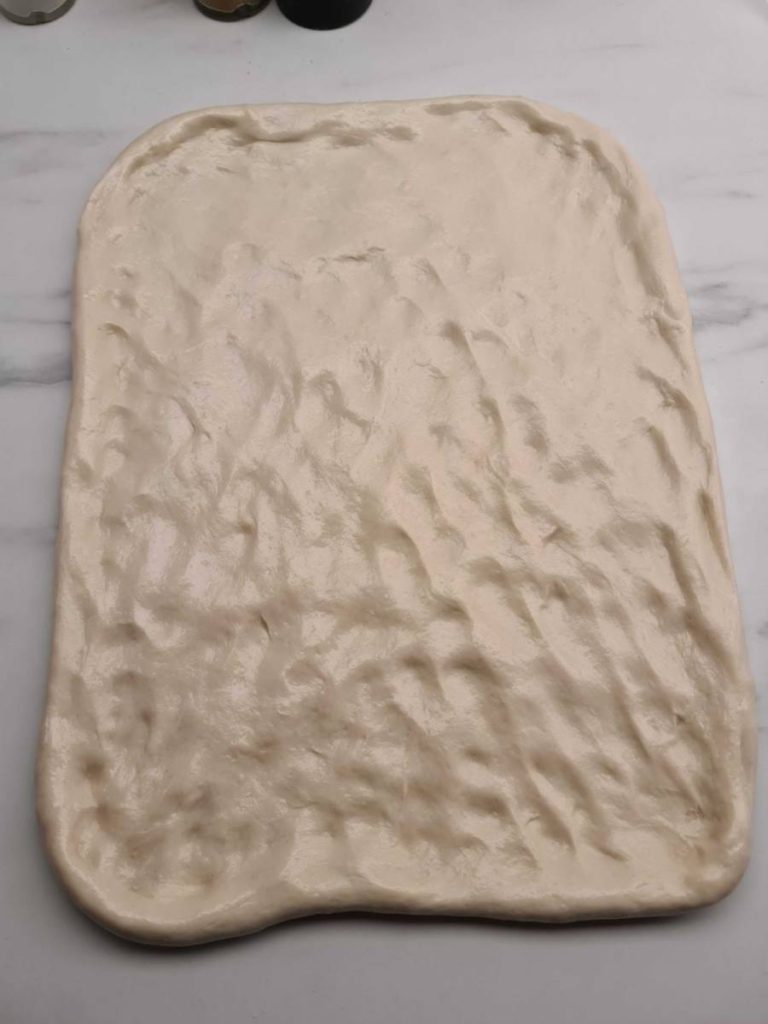
6. Top the Pizza
Add tomato sauce, cheese, and any other toppings you want!
7. Bake the Pizza
Bake the pizza for 30 minutes at 400°F (205°C), until the crust is nice and crispy and slightly brown.
If you’re baking the pizza on a pizza stone or
As mentioned in the baking section above, I also like to pre-bake the pizza without cheese and toppings to prevent overcooking. Simply bake the pizza with only sauce, take it out, top it after 20 minutes, and place it back in for the last 10 minutes.
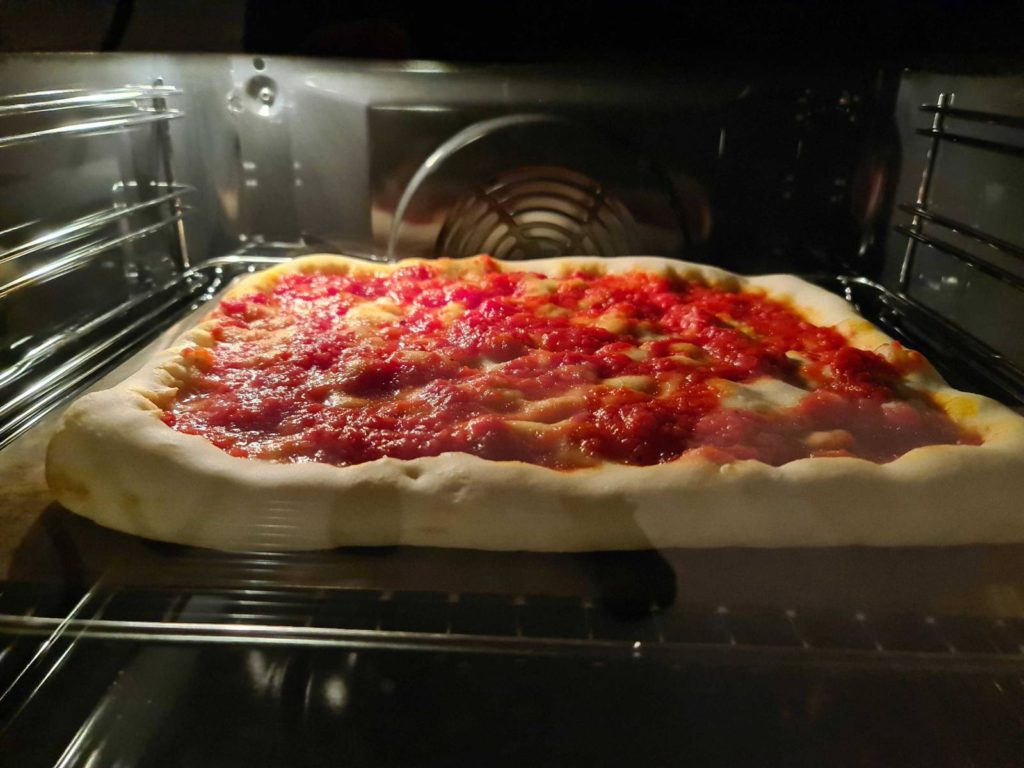
Related
Recipe Summary
The Best Sicilian Pizza Dough Recipe!
Ingredients
- 500 g pizza flour
- 335 ml water
- 7.5 g salt
- 5 g dry active yeast
- 10 g sugar
- 15 g extra virgin olive oil
Instructions
- Add room temperature water to a mixing bowl. Dissolve the sugar and yeast, and add the flour gradually while mixing. Add salt, and mix the dough so it comes together as a shaggy dough.
- Place the dough in an air-tight container, or in a bowl covered with plastic wrap. Let the dough rest for 30 minutes to let the gluten hydrate and ddevelo.
- Take the dough out of its container and knead it to a smooth, springy dough ball. This step can either be done by hand or in a stand mixer This should only take a couple of minutes.
- Place the dough in a lightly oiled airtight container or in a bowl covered with plastic wrap, and let the dough rise for 4-6 hours.
- Remove the dough from the rising container and stretch it out directly on a baking sheet or on a sheet of parchment paper. Use your fingertips and press it outwards from the middle into a rectangular shape. But make sure to keep an edge around the pizza. This will create a nice, raised crust!
- Top teh pizza with your favorite sauce, cheese and toppings.
- Bake the pizza for 30 minutes at 400°F (205°C), until the crust is nice and crispy and slightly brown.
- Is Your Pizza Dough Too Dry? Here is How to fix it! - June 10, 2024
- The Ultimate Guide to the Pizza Dough Windowpane Test - June 8, 2024
- The Ultimate Guide to Autolyse Pizza Dough - June 7, 2024




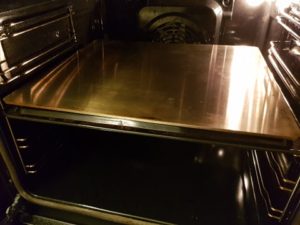
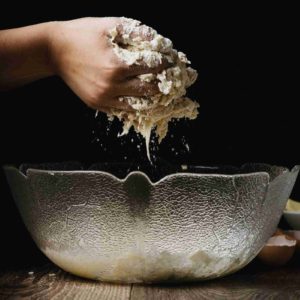


Thank you for the recipe, this turned out amazing!
Great!
You never said when to add the oil. pre autolyse or post autolyse.
Post 🙂
As a native NYer who has lived too long outside of NY but not in Italy, I’ve been trying for decades to find a homemade pizza that I can really say is as good as most pizzerias in Berlin, where I now am. After a few times with this dough, I finally did it. In addition to Adreas’s excellent explanations and details tips, for me using just about 2/3 of a can of pizza tomatoes with a spoon of sugar and then topping after initial bake with 2/3 Turkish kaseryi cheese and 1/3 fresh mozzarella did the trick. I’m used to low-moisture mozz in the US and the Turkish cheese (similar to the Greek or Bulgarian versions) gave the texture and meltability I was looking for. Spoon some fresh grated garlic oil and a nice sprinkle of oregano/basil/rosemary/thyme mix after baking and it was excellent.
I’m happy to hear that, and your pizza sounds amazing!
What are pizza tomatoes? Getting the right sauce is still my unreached goal. Loved this dough though!
San Marzano
Turned out perfect, thank you!
Love pan pizza and this turned out pretty good!
Andreas, thank you for all of your information on this site. So helpful! I’ve made the sicilian pizza twice now and it has turned out fantastic. Tonight I place sliced mozzarella directly on the dough, sauce on top with grated pecorino and baked it the full 30 minutes and it was perfection. This sheet had half banana pepper and italian sausage Also made a half sheet where I baked the dough with sauce only for 15 minutes and added buffalo mozzarella and fresh sliced pepperoni (with the casing to get the cup and char) for the last 15 minutes. Both were outstanding! Although my first love is Neapolitan Pizza, this is becoming a house favorite. Thank you again!
I’m happy to hear that! And the pizza sounds wonderful!
I made this tonight for impromptu company for supper. It was delicious! Thank you!
You mentioned pizza flour in a couple of your receipes.
Are you referring to BREAD flour, APF or OO ?
Thank you
Michael
I’m referring to Tipo 00 flour (e.g Caputo).